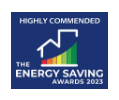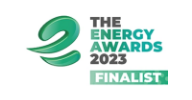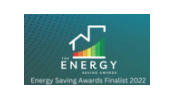In this three-part series Adveco considers the choices available to commercial organisations that wish to advance decarbonisation strategies in their buildings through the implementation of more sustainable hot water. In part 1 we considered the role of air source heat pumps as a source of low carbon preheat, now we turn our attention to using the sun with solar thermal systems…
Read Part 1 Sustainability & Hot Water – Which Path Is Right For Commercial Properties?
Using the sun to generate free heat from solar energy is a well-recognised and proven route for introducing renewables into a building project. As a high-temperature renewable source of hot water, solar thermal lends itself to working in conjunction with not only conventional gas heating but also other renewable technologies including air source heat pumps which can be used to provide pre-heat to solar thermal. This enables a variety of hybrid applications to be considered to meet the varied demands of commercial buildings.
Solar thermal systems are ideal for businesses that use and rely on large amounts of hot water, but it is important to understand that a solar thermal system will not fully replace your existing water heating system and will not provide space heating.
All areas of the UK are suitable for using the sun through solar energy technology; however, solar insolation, the energy generated from sunlight within collectors, will decrease as the sun’s inclination falls in the winter months and this is affected by how northerly located a building is in the UK as well as cloud cover. When it comes to using the Sun, solar thermal systems are obviously most productive in the summer months, when there is most sunlight, resulting in the additional need for either non-renewable energy sources or heat pumps which will still generate usable year round, even if ambient outside temperatures drop to -20°C during the winter months.
Shading from neighbouring buildings or tall trees, for example, can also greatly reduce a solar system’s output in which case a commercial air source heat pump would be a preferred alternative to produce low-carbon heat energy.
The actual percentage of your water heating demand covered by solar thermal will depend on your site and energy consumption habits (though this figure is typically around 30% for commercial sites). A south-facing and unobstructed roof with an inclination of 30° from the horizontal is optimal, though by no means essential as solar collectors can be installed in a variety of ways: built on the roof; built in roof; mounted on walls or on a frame construction to achieve inclination on flat roofs.
Sized and installed correctly, a single solar thermal collector can contribute up to 1400kWh per annum, providing electricity savings of £300 and more importantly reducing emissions of CO² by 322kg.
It is important to recognise that solar thermal differs from solar photovoltaic or Solar PV as it is known. Solar PV uses solar cells in a panel to convert the solar energy into electricity that can be stored, used as required, and even be sold back to the grid. Solar thermal works by a process of fluid heating in the collector panels that is then transferred via indirect heating in the cylinder into the hot water system. This requires basic plumbing for its installation and a minimum 3m drop to ensure flow. This does mean it is really only suited to installation on a building, rather than in the grounds, although that helps reduce the threat of vandalism compared to frames installed on ground level.
Giving consideration only to the hot water system, solar thermal is still more advantageous compared to equivalent-sized solar PV systems. For example, a 4kW solar PV system and the equivalent solar thermal system will cost almost the same to purchase and install, with minimal operational costs, but solar thermal will exhibit a much smaller physical footprint. A typical 4 kW PV system would require 16 collectors at 25m², whereas this would be matched by just three solar thermal collectors for a total footprint of 6.6m². This makes solar thermal a better choice for buildings with reduced roof space, especially if sustainable projects are intending to introduce a mix of solar thermal, heat pump and solar PV. The silent operation of solar is also a consideration factor.
To ensure system longevity and return on investment, fluid within the solar collectors must be correctly managed. If left in the panel it can overheat, stagnate and leave collectors irreparable. This can be avoided by incorporating Drain Back into solar system designs. This gravity flow approach reduces pump capacity requirements and energy use of the pump station to a minimum and will automatically drain fluid if power is cut without the need for working components. This makes solar thermal systems with drain back low maintenance with long operational lifespans. Fluid refresh is, on average, required every eight years but may last much longer.
Certain commercial system designs can demand a minimum of 45°C of preheat which, due to annual variation in production, could preclude the use of solar thermal as a lone preheat source. This does match the minimum working flow temperature for preheat that would be designed into a system utilising the current generation of air source heat pump.
Under such conditions, a typical sustainable application would see a cylinder sized to meet the storage requirements of the building’s hot water demands with the heat coming from a combination of an air source heat pump and solar thermal collectors working in conjunction to guarantee the preheat temperature. The heat pump, operating at optimal efficiency at lower temperatures will preheat the 5°C cold feed to 45°C at which point the solar thermal is employed to further raise temperature to 50 or 60°C depending on the time of year. Working together the renewables can offset the majority of the electrical costs otherwise required to heat the water, even during periods of peak demand.
Using the sun to provide energy to preheat a hot water application or top-up preheat in a hybrid hot water application is truly advantageous, but is not a singular response for the total hot water demand in commercial organisations. In the third and final part of this blog series we will we consider the future of gas and the adaptation to all-electric applications…
















